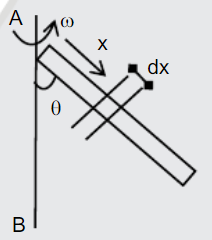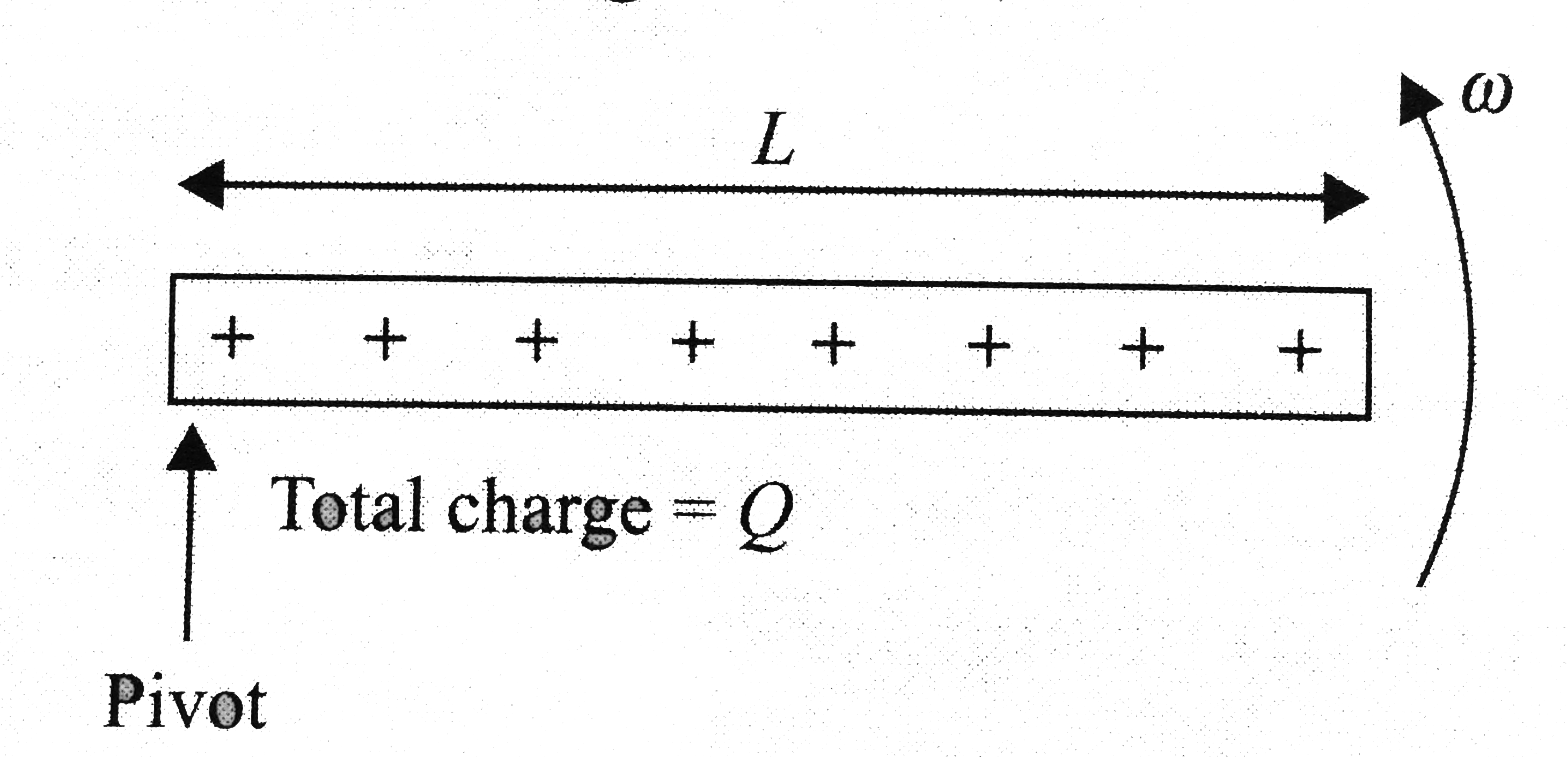A rod of length l and total charge 'q' which is uniformly distributed is rotating with angular velocity ω about an axis passing through the centre of rod and perpendicular to rod. Find the magnitude of magnetic dipole moment (in Amp. m2) of rod. If q=4C,ω=3rad/s and l=2m
To find the magnetic dipole moment m of a uniformly charged rotating rod, we can follow these steps:
Step 1: Define the charge distribution
Given a rod of length l and total charge q uniformly distributed, we can express the charge per unit length as:
λ=ql
where λ is the linear charge density.
Step 2: Consider a small element of the rod
Let’s consider a small element of the rod of thickness dx at a distance x from the center of the rod. The charge dq on this small element is given by:
dq=λdx=qldx
Step 3: Determine the current due to rotation
The rod is rotating with angular velocity ω. The time period T of rotation is:
T=2πω
The current I due to the charge moving in a circular path can be expressed as:
I=dqdt=dqT=dq2πω=qω2πldx
Step 4: Calculate the magnetic dipole moment of the small element
The magnetic dipole moment dm for the small element can be calculated using the formula:
dm=I⋅A
where A is the area of the circular path traced by the charge. The area for the small element at distance x is:
A=πx2
Thus, we have:
dm=(qω2πldx)⋅πx2=qωx22ldx
Step 5: Integrate to find the total magnetic dipole moment
To find the total magnetic dipole moment m, we need to integrate dm from −l2 to l2:
m=∫l2−l2dm=∫l2−l2qωx22ldx
Calculating the integral:
m=qω2l∫l2−l2x2dx
The integral ∫x2dx from −l2 to l2 gives:
∫l2−l2x2dx=(x33)l2−l2=13((l2)3−(−l2)3)=13(l38+l38)=l312
Substituting back, we have:
m=qω2l⋅l312=qωl224
Step 6: Substitute the given values
Now, substituting q=4C, ω=3rad/s, and l=2m:
m=4⋅3⋅(2)224=4⋅3⋅424=4824=2Ampere⋅m2
Final Answer
The magnitude of the magnetic dipole moment of the rod is:
2Ampere⋅m2
Given a rod of length l and total charge q uniformly distributed, we can express the charge per unit length as:
λ=ql
where λ is the linear charge density.
Let’s consider a small element of the rod of thickness dx at a distance x from the center of the rod. The charge dq on this small element is given by:
dq=λdx=qldx
The rod is rotating with angular velocity ω. The time period T of rotation is:
T=2πω
The current I due to the charge moving in a circular path can be expressed as:
I=dqdt=dqT=dq2πω=qω2πldx
The magnetic dipole moment dm for the small element can be calculated using the formula:
dm=I⋅A
where A is the area of the circular path traced by the charge. The area for the small element at distance x is:
A=πx2
Thus, we have:
dm=(qω2πldx)⋅πx2=qωx22ldx
To find the total magnetic dipole moment m, we need to integrate dm from −l2 to l2:
m=∫l2−l2dm=∫l2−l2qωx22ldx
Calculating the integral:
m=qω2l∫l2−l2x2dx
The integral ∫x2dx from −l2 to l2 gives:
∫l2−l2x2dx=(x33)l2−l2=13((l2)3−(−l2)3)=13(l38+l38)=l312
Substituting back, we have:
m=qω2l⋅l312=qωl224
Now, substituting q=4C, ω=3rad/s, and l=2m:
m=4⋅3⋅(2)224=4⋅3⋅424=4824=2Ampere⋅m2
The magnitude of the magnetic dipole moment of the rod is:
2Ampere⋅m2
Topper's Solved these Questions
- TEST PAPERSBook:RESONANCE ENGLISHChapter:TEST PAPERSExercise:PART - II PHYSICS
Explore 106 Videos
- SIMPLE HARMONIC MOTION Book:RESONANCE ENGLISHChapter:SIMPLE HARMONIC MOTION Exercise:Advanced Level Problems
Explore 13 Videos
- TEST SERIESBook:RESONANCE ENGLISHChapter:TEST SERIESExercise:PHYSICS
Explore 130 Videos
Similar Questions
A rod is rotating with angular velocity ω about axis AB. Find cosθ.

View SolutionA rod has a total charge Q uniformly distributed along its length L. If the rod rotates with angular velocity ω about its end, compute its magnetic moment.

View SolutionA rod has a total charge Q uniformly distributed along its length L. If the rod rotates with angular velocity ω about its end, compute its magnetic moment.

View Solutionfind the radius of gyration of a rod of mass m and length 2l about an axis passing through one of its ends and perpendicular to its length.
View SolutionMoment of inertia of a thin rod of mass m and length l about an axis passing through a point l/4 from one end and perpendicular to the rod is
View SolutionA uniform rod of mass M and length L carrying a charge q uniformly distributed over its length is rotated with constant velocity w about its mid point perpendicular to the rod. Its magnetic moment is
View SolutionThe radius of gyration of a uniform rod of length l , about an axis passing through a point l8away form the centre of the rod , and perpendicular to it is:
View SolutionThe radius of gyration of a uniform rod of length l , about an axis passing through a point l8away form the centre of the rod , and perpendicular to it is:
View SolutionA metallic rod of length I rotates at angular velocity ω about an axis passing through one end and perpendicular to the rod. If mass of electron is m and its charge is -e then the magnitude of potential difference between its two ends is
View SolutionA non-conducting rod AB of length l has total charge Q . The rod is rotated about an axis passing through a point (l/3) distance from one end and perpendicular to plane of rod with constant angular speed omega, the magnetic moment of rod is
View Solution